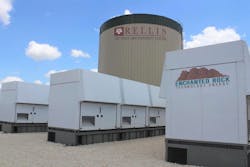We continue our article series exploring the state of the grid and improving energy solutions for evolving digital infrastructure power needs. This week, we’ll look at the makings of a modern microgrid.
Get the full report.
Rob Thornton, president and CEO of the 105-year old International District Energy Association, often says that microgrids are “more than diesel generators with an extension cord.” In other words, a microgrid is not just for backup generation. Still, it should be a robust, 24/7/365 asset that provides primary energy services to a market. A microgrid can provide backup generation, but it offers additional, more intricate services as well.
What can microgrids accomplish? Consider this list:
- Produce onsite generation and optimally thermal energy to be economically competitive
- Serve a distinct, interconnected load, usually with multiple buildings or meters, within a defined geographical boundary or business district
- Can act as a single, controllable entity within the central grid
- Can operate in parallel to the grid, as a grid collaborator, not a competitor
- Can connect or disconnect (island) from the central grid during interruption events with black-start capability
- May participate in demand response and buy power from the grid or sell energy, capacity, and ancillary services to the grid, depending on economics/pricing
- Provide energy 24/7, 365 days a year
- Provide Microgrid-as-a-Service capabilities
- Often incorporate advanced controls and communications and automation software for transparent and intelligent energy management and demand response
- Include distribution wires
- May use any form of fuel but are likely to run on CHP/natural gas, fuel cells or solar energy, and sometimes wind power; making them far greener solutions as opposed to only gas- or diesel-powered generators
- May include thermal and electric storage
- A microgrid is a group of interconnected loads and distributed energy resources that acts as a single controllable entity concerning the grid. It can connect and disconnect from the grid to operate in grid-connected or island mode. Microgrids can improve customer reliability and resilience to grid disturbances.
Advanced data gathering from numerous operational microgrid deployments allows leading partners to make better decisions and proactively service units.
A fundamental feature of a microgrid is its ability to island — meaning it can disconnect from the central grid and operate independently and then reconnect and work in parallel with the grid. So, for example, whenever there is a significant storm or another natural weather event that potentially causes an outage on the power grid, the microgrid islands and activates its onsite power generators. When the power outage ends, the microgrid reconnects to the grid.
A microgrid controller gives the microgrid its islanding capability and new, data-driven capabilities. Also known as the central brain of the system, the controller can manage the generators, batteries, and nearby building energy systems with a high degree of sophistication. The controller orchestrates multiple resources to meet the energy goals established by the microgrid’s customers by increasing or decreasing the use of any of the microgrid’s resources — or combinations of resources. These types of solutions can also create microgrid-as-a-service capabilities.
Microgrid-as-a-service delivers a fully managed, data-driven solution to help you with your power delivery requirements. Advanced data gathering from numerous operational microgrid deployments allows leading partners to make better decisions and proactively service units. This type of managed offering will enable customers to never worry about their microgrid unit; it’s all serviced, monitored, and maintained by your microgrid provider.
Let’s pause here and explore one more emerging topic related to the technology. Power-as-a-service is becoming a reality as smarter microgrids take on more power intelligence than ever before.
According to NREL, advanced microgrids enable local power generation assets — including traditional generators, renewables, and storage — to keep the local grid running even when the more extensive grid experiences interruptions or remote areas with no connection to the larger grid. In addition, advanced microgrids allow local assets to work together to save costs, extend the duration of energy supplies, and produce revenue via market participation. They usually include the following capabilities:
- Microgrid system modeling and simulation on timescales of electromagnetic transients and dynamic and steady-state behavior
- Development of power electronic converters and control algorithms for microgrid integration
- Controller hardware-in-the-loop testing, where the physical controller interacts with a model of the microgrid and associated power devices
- Power hardware-in-the-loop testing of microgrid hardware
- Programmable A.C. power supplies (grid simulators) to emulate the grid-tie as well as select electrical nodes on the microgrid
- Programmable DC power supplies to emulate photovoltaic (P.V.) arrays and battery banks
- Hybrid microgrid testing, including the distribution integration of wind turbines, P.V., dynamometers, loads, and energy storage
They also act as dual-purpose microgrids providing resiliency and grid stability. What does that mean? Dual-purpose microgrids are local power systems that offer sustained resiliency services to customer sites to survive long-duration power outages and provide support services to the larger grid and wholesale markets, which reduces the overall cost of each of these services.
Source: Enchanted Rock
The image above illustrates how dual-purpose microgrids provide the essential local resiliency services of a microgrid (the ability to create an island of power when the larger grid goes down) and are ready to provide grid stability services when the grid is up and running. For example, when the wind unexpectedly dies down in a state like Texas, which leads the U.S. in installed wind power capacity at approximately one-third of all capacity, other resources must be called upon to fill the void. These supplemental resources need to respond within a brief period of time.
It’s important to note that dual-purpose microgrids do not compete with grid-supplied power. Instead, they displace our historical reliance on backup diesel generators, which represent one of the most polluting of all power generation options. They also generate a new revenue stream by supporting the broader grid during times of crisis. We’ll touch on that last part later.
Aside from generating a revenue stream, modern microgrids aim to become a bridge to alternate fuel sources in the future.
Microgrids and the Modernization of Power Resources
A recent report from Guidehouse Insights states that traditional microgrids such as solar plus storage, fuel cells, or combined heat and power (CHP) focus on providing 24/7 electricity, going into island mode as long as possible during a grid outage. Their purpose could be described as meeting the demand for local resiliency services at a specific site. Ideally, these microgrids could sustain electricity supply during long-duration outages. Dual-purpose microgrids also generate a cost offsetting revenue stream by supplying services to the broader grid during emergencies. These dual-purpose microgrids are critical to making a commercial reality of the energy transition to a low-carbon energy future. Why do we need these types of microgrids today? The provision and use of electricity are rapidly changing in profound ways:
- The energy transition is driving growth in variable renewable energy and retirement of baseload production, and at the same time, electrification of previously fossil-fueled energy uses is growing. According to Princeton University, the U.S. will need to quadruple wind and solar power to reach 600 GW, which would serve about half of the nation’s electricity demand to get to the net-zero carbon goal by 2030 at the cost of $2.5 trillion.
- Critical infrastructure is now recognized as expanding significantly beyond hospitals and emergency services to include a much longer list of essential facilities to maintain safety, health, food, water, and communication. More businesses and organizations require continuous electricity to deliver these services to society.
- Climate change increases the number and impact of severe weather events causing large-scale power outages, including fires, ice storms, extreme cold and heat, hurricanes and flooding, and high winds. According to the U.S. Environmental Protection Agency (EPA), eight of the ten warmest years on record for the U.S. have occurred since 1998. Furthermore, nine of the ten most extreme 1-day precipitation events have occurred since 1990. The EPA also reports that single-day extreme precipitation events have increased by half of a percentage point each decade since 1910. While long-term trends show significant variability in the frequency of hurricanes, 2017 was the worst year in U.S. history, with 17 named storms causing $200 billion in damages.
New microgrid solutions take sustainability to a new level, focusing on the transition to low-carbon energy use. New microgrid solutions now offer customers renewable natural gas (RNG) as a direct fuel source. RNG results from capturing and delivering methane emissions from decomposing waste at landfills, agricultural waste, and water treatment. When injected into the existing natural gas pipeline system, it displaces the use of fossil-based gas, thus reducing the carbon equivalent emissions to zero or negative, depending on the source of the RNG.
The significant part is that RNG microgrid projects are already in the wild. Initially funded by $20 million from Congress, the San Diego, California Miramar Air Force Base microgrid is considered one of the most sophisticated under development with five distributed energy resources, including solar, energy storage, landfill gas, diesel, and natural gas plant, and E.V. charging. Given the worldwide need to manage waste — especially in light of rapid urbanization — the search is underway for ways to make productive use of gases emitted from landfills. According to World Bank, the world generates about 2.01 billion tons of municipal waste, a figure expected to grow 70% over the next 30 years.
Resources within the Miramar microgrid
- 1.3 MW solar photovoltaics
- 3.2 MW landfill gas
- 6.45 MW diesel and natural gas power plant
- 1.6 MW HVAC demand response
- 157 kW thermal energy storage
- E.V. charging station control
- 3 M.W. energy storage (microgrid system level)
- 390 kW building-level energy storage (Lithium-Ion and zinc flow batteries and vehicle-to-grid bi-directional hybrid vans)
- SCADA system upgrades
- Advanced microgrid control system
- Energy and Water Operations center (EWOC)
Completed in 2021, the Marine Corps Air Station Miramar in San Diego microgrid can electrify the base’s 100 mission-critical buildings, including its entire flight line, even during a power outage. According to a recent US Marines statement, many installations may have a backup generator, but the microgrid is a more refined generation source. It establishes the capability for operators to manage the power load and everything plugged into the grid while redirecting power to parts of the base that need it most. At MCAS Miramar, a mission- critical function that would require power is flight line operations.
Here’s another remarkable fact: modern microgrids not only produce minimal emissions, but they’re also very quiet. New microgrid solutions operate at less than 68 dBa, which is suitable for urban use and offers no disruption to business operations. Just for reference, everyday conversational speech usually measures at around 60dBa.
Even with these advancements, there are still reservations about deploying modern microgrids. It’s essential to break down some of those historical perspectives to understand the future of power delivery, sustainability, and resiliency.
Download the entire special report, “The State of the Grid: Improving Energy Solutions for Evolving Digital Infrastructure Power Needs” courtesy of Enchanted Rock to learn more. In our next article, we’ll look at energy and resiliency as a service and renewable natural gas. Catch up on previous articles here and here.
About the Author



